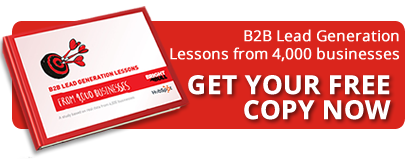
One of the trickiest thing your marketing team must do, in order to better understand and target your audience, is profile your customers and prospects, before they go to sales.
Assuming you are doing content marketing, without a good understanding of the needs, wants and pains of your ideal customer, it’s nearly impossible to create content that sticks, and therefore profile your audience.
So what is different now? How are modern marketers using content and technology to profile their prospect customers before they become an SQL? Lets see.
The old school approach to B2B prospect profiling:
Manual checks
There was a time when manually checking each individual record and company was the most effective way of acquiring more information about contacts, and recording which type of customer segment they represent. Traditionally this was a long and laborious process carried out by someone in your database or research team. Sound uninspiring? Imagine how much of a job this is when you're dealing with a significant sized database...
Result: This method is very subjective, very time consuming and often inaccurate.
External validation
Another (very outdated) means of profiling B2B prospects and customers, and corroborating the details you held on your database was using an external company (usually outsourced to India) to validate email addresses, job titles and telephone numbers by calling individuals and asking them directly. No matter how sophisticated these organisations claimed to be, almost all of them used a part human and part automated approach to confirm that your prospects are who you think they are.
Result: This technique was also not infallible, as it heavily relies on technology being able to profile individuals, and a human element which is so far removed from your business that it’s unlikely you’ll get the desired outcome.
Surveys
One way of getting customers to do the hard work for you (if you can convince them to take part), is by sending out a survey that includes questions where they self select their profile from a predefined list.
Result: For those that do take part, you’ll be much closer to a better set of data which you can then use to target your marketing far more effectively. However, you're probably only going to see a 5-10% survey response rate - and that's even with a nice incentive.
The new school approach to B2B prospect profiling:
Now, the optimum way of collecting information about your B2B customers and prospects is using marketing platforms or other technology as part of your website, so you can track the behaviour of visitors to your site. This means each visitor will leave a trackable trail of behaviour on your website, even if they haven't yet filled out a form.
So what’s a fool proof way of collecting relevant data and gaining customer insight?
Well defined buyer personas
You and your marketing team should know the areas of interest most relevant to your ideal customer (and theoretically these should mirror your internal interest areas). Remember to continually review these buyer personas, and check that they are represented across the marketing efforts of your team.
Structured website areas
Your areas of interest and profiling criteria should be well represented on your website. Some companies have areas relevant to different personas, sectors or industries. Others have clearly identified areas within the site that are relevant for different stages of the buying cycle. Through your marketing platform, this will allow you to identify areas of interest even if someone only gives you their email address through a form.
Appropriate content
Be sure that your content directly appeals to your buyer personas. Even if you have a killer content idea that could appeal to a broad number of visitors, if it doesn’t truly represent your offering as a business, the contacts acquired from posting it will not be relevant further down the funnel. Then you’ll have your sales teams complaining that the leads you're generating are not great. Definitely want to avoid that!
Value add content
Instruct your marketers to create added value content that fits your areas of interest (things like ebooks, whitepapers and reports) and place it behind a form. This opens up great insight for you as a business to understand your prospects painpoints and also gives your visitors the opportunity to show interest in a product or service - all helping the sales teams profile contacts and where they sit in the funnel. Of course it goes without saying that creating added value content will attract more visitors and leads to your site too!
Progressive or “smart” profiling
Ensure your teams use progressive profiling within forms to capture any additional elements you might want to obtain from contacts. This means that people can fill in information as they engage with you. This allows you to keep forms as short as possible, while still acquiring key information about prospects through their interactions. This uses the principle of give-get.
Social prospecting
As you use content to understand individual’s behaviour and then define their needs and stages in their buying cycle, you can use the same methodology by using social prospecting. This simply means scouring relevant social media channels to understand who is talking about what and tapping into conversations around a pain that you or your product solves - then tempting them to come to your website with your great content.
With this 6-pronged profiling approach, marketers will be able to easily assess the areas of interest for different segments of your database, and most importantly tailor marketing communications based on your findings. These new methods ensure greater accuracy and relevance, and present a far more sophisticated solution to the task of profiling target customers than the old school standards.

